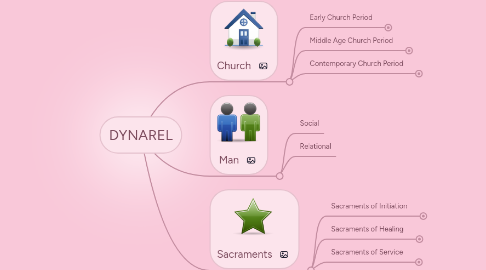
1. Sacraments
1.1. Sacraments of Initiation
1.1.1. Baptism
1.1.2. Eucharist
1.1.3. Confirmation
1.2. Sacraments of Healing
1.2.1. Anointing of the Sick
1.2.2. Penance or Reconciliation
1.3. Sacraments of Service
1.3.1. Matrimony
1.3.2. Holy Orders
2. Man
2.1. Social
2.2. Relational
3. Church
3.1. Early Church Period
3.1.1. Origin
3.1.1.1. Pentecost Spirit
3.1.2. Beliefs
3.1.2.1. Brotherhood
3.1.2.2. Law of Love
3.1.3. Foundation
3.1.3.1. Jesus Christ
3.1.3.2. The Apostles
3.1.4. Models
3.1.4.1. Political Society
3.1.4.1.1. Institutional
3.1.4.1.2. Hierarchical
3.1.4.1.3. Perfect
3.1.4.2. Body of Christ
3.1.4.2.1. Democratic
3.1.4.3. Sacramental
3.1.4.3.1. Salvation
3.1.4.3.2. Spiritual Purification
3.1.4.4. Pilgrim People
3.1.4.4.1. People of God
3.1.4.5. Servant Model
3.1.4.5.1. Jesus Christ
3.1.5. Symbols
3.1.5.1. Sheepfold
3.1.5.2. Cultivated Land
3.1.5.3. Building of God
3.1.5.4. Mother
3.1.6. Great Heresies
3.1.6.1. Circumcisers
3.1.6.2. Gnosticism
3.1.6.3. Montanism
3.1.6.4. Sabellianism
3.1.6.5. Arianism
3.1.6.6. Pelagianism
3.1.6.7. Semi-Pelagianism
3.1.6.8. Nestorianism
3.1.6.9. Monophysitism
3.1.6.10. Iconoclasm
3.1.6.11. Catharism
3.1.6.12. Protestantism
3.1.6.13. Jansenism
3.1.7. Church of Constantine
3.1.7.1. Developments
3.1.7.1.1. Doctrine
3.1.7.2. State
3.1.7.2.1. Interfered in life of the Church
3.1.7.3. 380 AD
3.1.7.3.1. State Religion
3.1.8. Episcopal Councils
3.1.8.1. Nicaea I
3.1.8.2. Constantinople I
3.1.8.3. Ephesus
3.1.8.4. Chalcedon
3.1.8.5. Constantinople II
3.1.8.6. Constantinople III
3.1.8.7. Nicaea II
3.1.8.8. Constantinople IV
3.1.8.9. Lateran I
3.1.8.10. Lateran II
3.1.8.11. Lateran III
3.2. Middle Age Church Period
3.2.1. Church Fathers
3.2.1.1. Latin
3.2.1.1.1. St. Ambrose
3.2.1.1.2. St. Jerome
3.2.1.1.3. St. Augustine
3.2.1.2. Greek
3.2.1.2.1. St. Athanasius
3.2.1.2.2. St. John Chrysostom
3.2.1.2.3. St. John Damascene
3.2.2. Achievements
3.2.2.1. Papacy Upheld
3.2.2.2. Constitutional Monarchy
3.2.2.3. Craft Guilds
3.2.2.4. Monasticism
3.2.2.4.1. Vows
3.2.2.4.2. Prayers
3.2.2.4.3. Work
3.2.2.5. Inventions
3.2.2.5.1. Paper
3.2.2.5.2. Linen and Satin
3.2.2.5.3. Spectacles
3.2.2.5.4. Watches
3.2.2.5.5. Organs
3.2.2.5.6. Mariners' Compass
3.2.2.5.7. Stained Glass
3.2.3. Crusades
3.2.3.1. United Christendom
3.2.3.2. Feudalism Weakened
3.2.3.3. Papal Power Strengthened
3.2.3.4. Western and Eastern Cultures Met
3.2.3.5. Saved Europe from Islam
3.2.3.6. New Trade Routes
3.2.4. Reformation
3.2.4.1. Causes
3.2.4.1.1. Doctrinal Differences
3.2.4.1.2. Idealism
3.2.4.1.3. Weakness in Church
3.2.4.1.4. Corruption
3.3. Contemporary Church Period
3.3.1. Vatican Council I
3.3.1.1. Papal Infallibility
3.3.1.2. Centralized Authority
3.3.1.3. Marian and popular devotion
3.3.1.4. Mass Attendance
3.3.1.5. Vocation
3.3.1.6. Hospitals
3.3.1.7. A world force
3.3.2. Vatican Council II
3.3.2.1. John XXIII
3.3.2.2. Laity’s full participation
3.3.2.3. Vernacular liturgy
3.3.2.4. Maximum participation of lay leaders
3.3.2.5. Religious freedom
3.3.2.6. Ecumenism
3.3.2.7. Decree in Media
3.3.2.8. Scientific Mentality
3.3.2.9. Expanded view of revelation
3.3.2.10. Pope and college of Bishops
3.3.3. Philippines
3.3.3.1. Evangelization
3.3.3.1.1. Augustinians
3.3.3.1.2. Franciscans
3.3.3.1.3. Jesuits
3.3.3.1.4. Dominicans
3.3.3.1.5. Recoletos
3.3.3.2. Missionary Activity
3.3.3.2.1. Social Involvement
3.3.3.2.2. Christian Charity
3.3.3.2.3. Religious Instruction
3.3.3.3. Anti-Friar Movement
3.3.3.3.1. Aglipayanism
3.3.3.3.2. Protestantism
3.3.3.3.3. Iglesia ni Cristo
3.3.3.4. Plenary Council
3.3.3.4.1. Community of Disciples
3.3.3.4.2. Church of the Poor
3.3.3.4.3. Empowerment of the Laity
